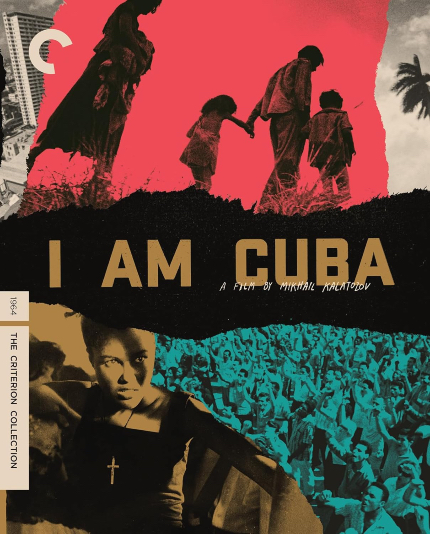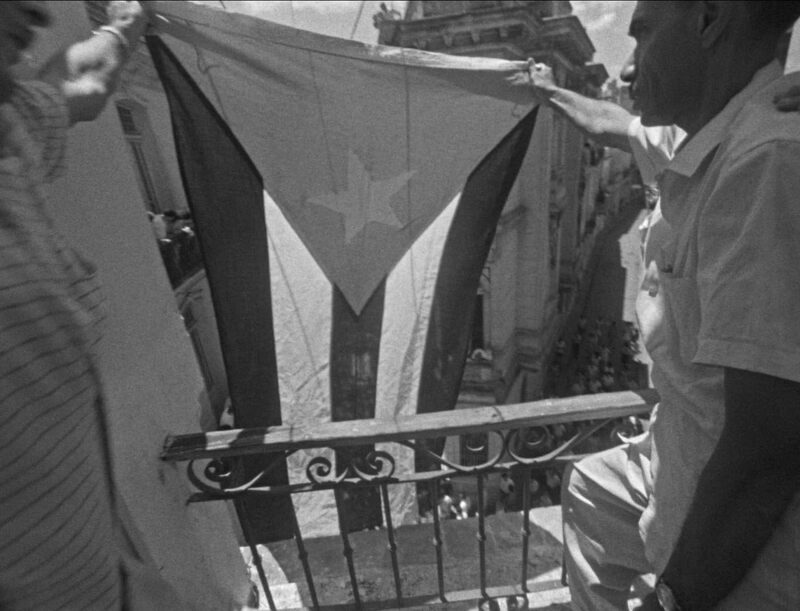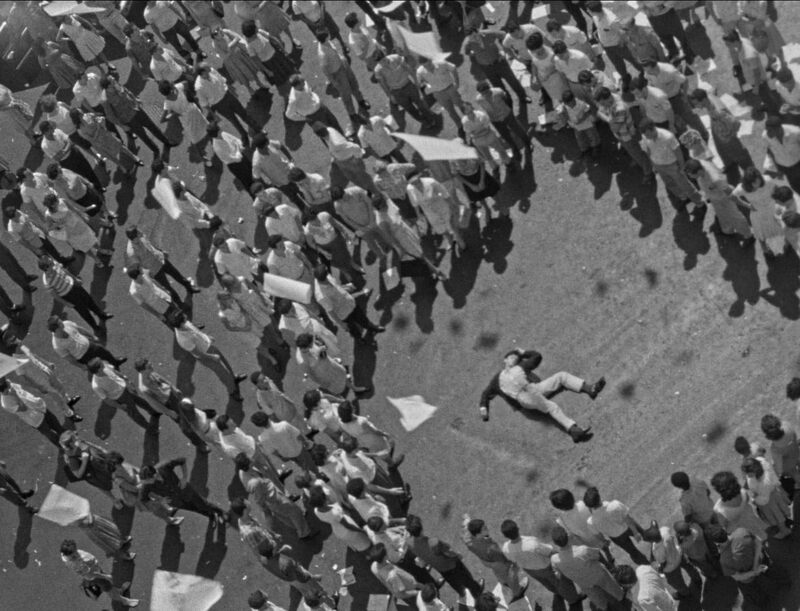I AM CUBA 4K Review: Near Perfect, A Reeling Contradiction
Director Mikhail Kalatozov’s enigmatic look at pulsating revolutionary Cuba is “reality through bombast.”

Not quite a documentary, not quite fiction, Soviet director Mikhail Kalatozov’s I Am Cuba (Soy Cuba) is something of a reeling contradiction.
Though working with a cast largely made up of inexperienced locals and crew members, foreigner Kalatozov crafted a near-perfect film, an oneiric drift built upon palpable real-world struggles uniquely depicting Cuba’s “tropical revolution” of the late 1950s and early 1960s.
Terrible plights give way to potential fights in this intensely political piece of revered World Cinema yet remains refreshingly free of outright lectures. Instead, I Am Cuba (1964) is more or less an anthology film, its segments thematically and aesthetically linked as the work of singular filmmaker Mikhail Kalatozov. Unlike most anthology films, every segment is justifiable and truly powerful in both artistic execution and as communist political propaganda.
The first of the four segments is a sobering contrast between the busy and glamorous American casino scene in Havana and the nearby shantytown where locals struggle to get by. The rich casinos are where young Maria (Luz María Collazo), under the pseudonym of “Betty” and unbeknownst to her fiancé, earns money as a sex worker. Her concession to bring her latest back to her meager shanty dwelling goes incredibly badly, reducing the poor girl to tears and a potent metaphor for capitalist exploitation of the least of these.
Things get increasingly bleak in the second story, a tale of a sugarcane farmer, Pedro, (José Gallardo) who is served notice to vacate his hard-worked land, as it’s been sold to a big company. That Pedro lies to his children that all is well before sending them away for a day of fun in town only compounds the tragedy that follows.
The third segment is about a radicalized student at Havana University who, amid the spirit of campus protest, becomes determined to assassinate the chief of police. Will he go through with it? Leaflets dramatically take to the air following one of the film’s most grandiose unbroken camera shots.
Social trauma reaches a fever pitch in the fourth story, in which another farmer resists the invocation to join the local armed rebellion. Motivation, however, comes soon enough in the form of a bombing raid that claims his home… and worse. His subsequent change of heart which provides I Am Cuba a solid moment of collective nationalistic fervor suitable to go out on.
While it’s fair to say that I Am Cuba never insists upon binding the viewer in the small country’s then-hotbed of political weeds, it doesn’t exactly hold one’s hand throughout. It is an artful film, as blunt as it can be mysterious. In its quest to manufacture an undeniable piece of Soviet propaganda, it finds itself floating well over the heads of the gathered masses.
Cameras literally scale up the outsides of buildings then defy gravity over throngs of demonstrators in the streets below. It makes serpentine weaves through crowded areas thick and thin before following a lounging bourgeois sunbather into the nearby pool and underwater. (All this with cumbersome and sensitive equipment that predates steadicams and digital video). From a sprawling almost-two-year production, a unique masterpiece emerged; one ominous yet luminous, luminous yet ominous.
Spearheading the project was the Instituto Cubano del Arte, known more commonly as the ICAIC, the first cultural institution created by Cuba’s revolutionary government. As the story goes, a deal with the ICAIC and the communist mothership was made: The Soviet Union, happy to spare no expense on select filmmaking endeavors -- see: Sergei Bondarchuk’s blank-check-state-financed six-plus-hour 1965 adaptation of War and Peace -- would finance a feature film about life in communist Cuba.
Certain extravagances and an unusually long production phase, pushing two years, would not be issues. Should it, though, for whatever reason, be deemed undesirable for release, the Soviet authorities would promptly shelve it. And that’s just what they did.
What was the problem? Thumbs-down opinions and barbed accusations claimed that Kalatozov’s ambitious enigma of a film was too enmeshed in aloof westernized style and sensitivities. Or something to that effect. The Powers That Be in Russia really didn’t like it, and neither did much of the Cuban populace that got to see it.
Circa 1994, I Am Cuba was restored, re-released, with the big-name backing of Martin Scorsese and Francis Ford Coppola, and greatly reassessed. Previously, attitudes about the film were anything but glowing. This is evidenced in the 2004 documentary about the film and its tumultuous history, I Am Cuba, the Siberian Mammoth, included as a supplement on the Blu-ray disc found in this set. Locals had, for decades, considered the film a grandiose experiment at best and an embarrassing debacle at worst. Many were shocked to learn to just what degree it’s become celebrated.
Though extras are slim on this release, what we do get is worthy of note. Criterion preserves a brief 2003 interview with filmmaker Martin Scorsese about the revival of I Am Cuba. It’s interesting to hear the prominent American director recall his own recruitment into the re-release/restoration effort of the film. One gets an authentic sense of the kind of cinema-induced delirium that Scorsese exists and operates within.
The only newly produced extra is an on-camera appreciation of the film by cinematographer Bradford Young (Arrival; Selma). Perhaps to make up for the lack of any other fresh extras, Young’s edited interview goes well longer than the now-typical 20+-minute running time. Although it’s mostly his talking head, he is passionate, smart, and well-informed about I Am Cuba, it’s intended purpose as propaganda, and its many nuances. A cinematographer interview may not be much of a selling point to many commoners, but then again, this is I Am Cuba, not Solo: A Star Wars Story (which Young shot first).
All the edition’s extras, also including the film’s trailer, are found on the accompanying Blu-ray disc, leaving the movie more room to breathe on the neighboring beautiful 4K disc. It all comes housed in a plastic Criterion keep case adorned with vibrant new illustrations by Century. The Spanish language film is supplemented with newly translated opinional English subtitles. The film can also be viewed with an alternate Russian-dubbed soundtrack.
Film critic Juan Antonio García Borrero- writer of “The Filmmakers Who Came in From the Cold”, Criterion’s printed essay for this release- showers credit where credit is very much due, citing “Carlos Fariñas’s stirring score and the dazzling camera work by Sergei Urusevsky” as major contributions to the memorable greatness of I Am Cuba. Together, they would thoroughly realize Kalatozov’s priority of demonstrating (as Borrero puts it,) “reality through bombast.”
Kalatozov and DP Urusevsky worked together previously to create the fellow Cold War themed masterwork The Cranes are Flying (which is also available via Criterion). That immediately celebrated film took the 1958 Cannes Film Festival Palme d'Or, that festival’s top honor. Urusevsky, we’re told, flat out refused to film an outdoor scene if the sky was clear, as “a sky without clouds is not interesting.” In any case, his renderings of skies with clouds are images that don’t leave you.
I Am Cuba is a film that simply belongs in the Criterion Collection, in every sense. Outside of its stable of self-propelled propelled World Cinema masters, it’s films precisely like this that many think of when the company is mentioned. Irrepressibly irradecent and awash in visual verve, Mikhail Kalatozov’s masterful mutt remains essential cinema of the highest order.
Criterion’s official listing of supplemental content:
• 4K digital restoration, with uncompressed monaural soundtrack
• One 4K UHD disc of the film and one Blu-ray with the film and special features
• “I Am Cuba,” the Siberian Mammoth, a 2004 documentary on the making of the film featuring key participants
• Interview from 2003 with filmmaker Martin Scorsese
• New appreciation of the film by cinematographer Bradford Young
• Trailer
• Alternate Russian-dubbed soundtrack
• New English subtitle translation
• PLUS: An essay by film critic Juan Antonio García Borrero
New cover by Century
I Am Cuba
Director(s)
- Mikhail Kalatozov
Writer(s)
- Enrique Pineda Barnet
- Yevgeniy Yevtushenko
Cast
- Sergio Corrieri
- Salvador Wood
- José Gallardo









